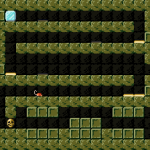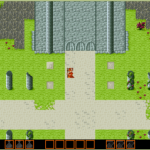By popular demand, I’m going to continue this series and dig up some of the relics of the Soulcaster design process. In part 1 I talked about lightweight design and posted shots of a few levels that ended up on the scrap heap. Well for today I’ve found a special treat: the original design document of Soulcaster 1.
I haven’t edited anything besides coloring the text. Stuff in red is stuff that never made it into the final design. Italics are annotations I’m writing today.
Tower Defense Adventure
like tarchon, but more focused on individual rooms with finite enemies and handling “waves” perhaps [Tarchon was an earlier concept featuring one-player party-based dungeon exploration]
take your party into a dungeon room and you start to get attacked. you need to fight your way from room to room within a floor, surviving waves of mobs. when one aggros, all others in a small radius aggro, so they start filing in for the attack. [I never tested this behavior, and it would be cool to have leader and following types of enemies in the future]
there are choke points like in any tower defense so you are facing waves of guys.
basically you set up your defenses by placing party members at key locations. you have ranged units who can fire at enemies, or over walls. aoe based attacks and that sort of thing. there are melee units, some of them can set up barricades. other disables such as stuns are also available. [There were no barricades or stuns. Status effects is something I hope to introduce in SC3, though it will be time consuming to balance.]
when you place a party member, he stays in one spot and executes a simple script. usually it will mean just firing at any enemy in range. it can also mean moving within a small radius to melee attack enemies that come that way. [The random skeleton friends in SC2 were an experiment with melee allies. I could experiment with it a bit more, but for the first game it took away from the unit placement strategy.]



